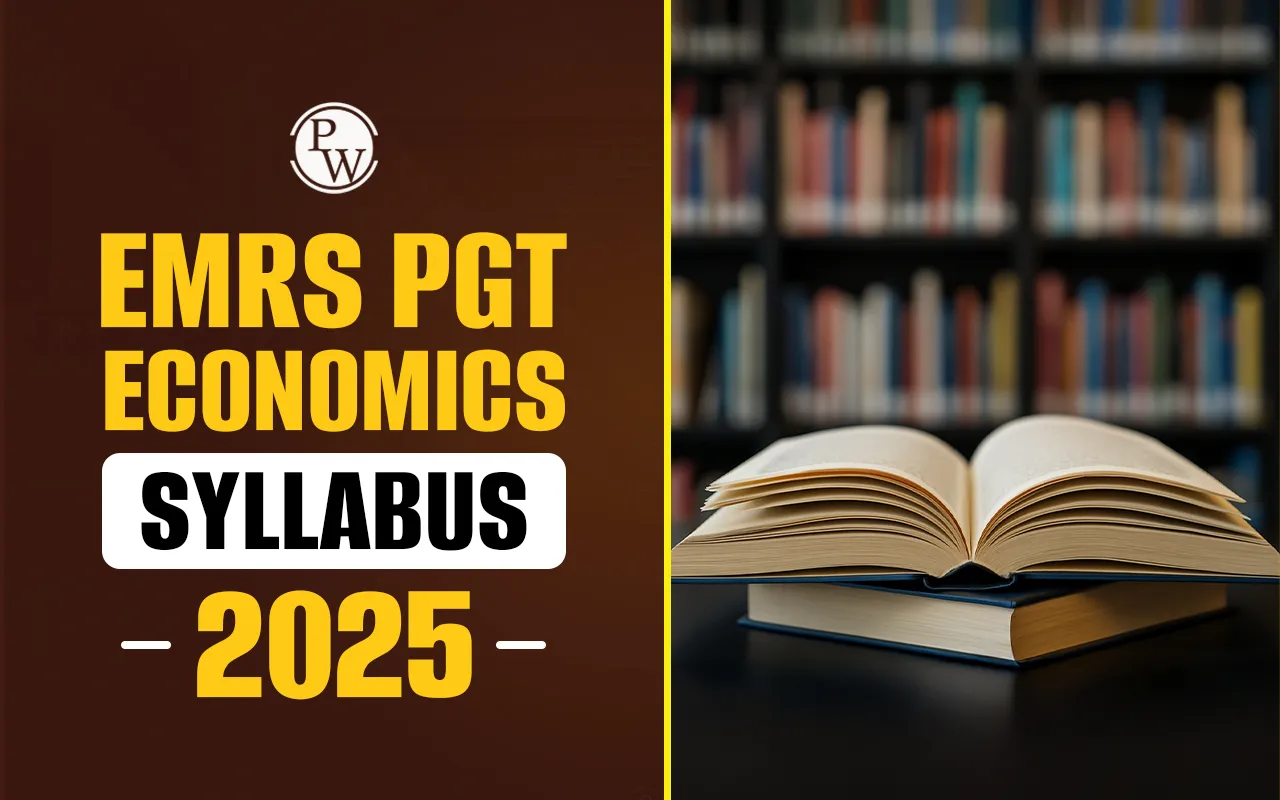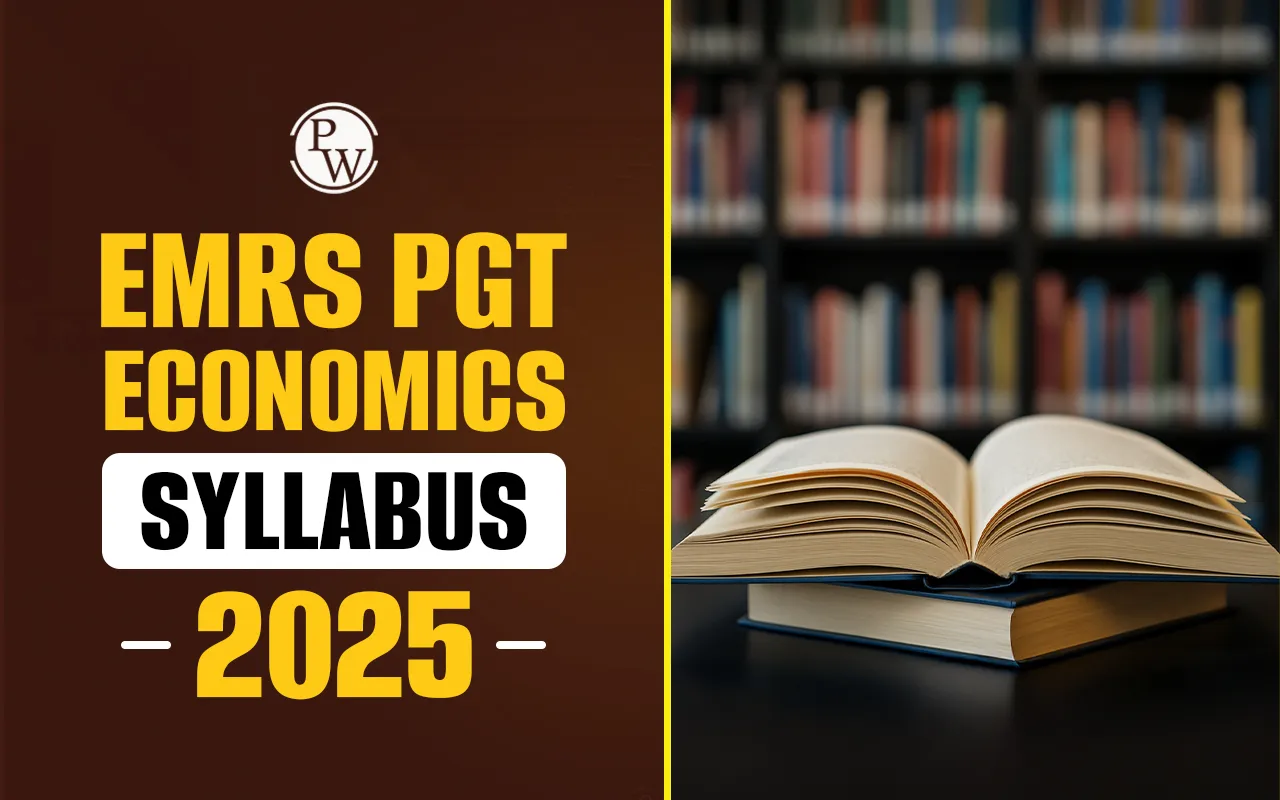

EMRS PGT Economics Syllabus 2025: Candidates who are interested in pursuing their teaching career and applied for the EMRS PGT Recruitment 2025 will have to appear in the subject-specific exam that decides the merit order. Candidates who have applied for PGT Economics. They should refer to the EMRS PGT Economics Syllabus 2025. It has been provided in the EMRS PGT Notification 2025. Candidates can get an idea of the topics to cover in the exam preparation.
EMRS PGT Economics Syllabus 2025 Overview
EMRS PGT Economics Syllabus 2025 knowledge can help the candidates to align their preparation strategies. They have to face objective and descriptive questions in the subject-specific exam.
| EMRS PGT Economics Syllabus 2025 Overview | |
| Conducting Body | National Education Society for Tribal Students (NESTS) |
| Post Name | Post Graduate Teacher (PGT) Economics |
| Examination Mode | OMR-Based/Online (Generally) |
| Total Parts in Exam | General Paper + Subject-Specific Paper |
| Negative Marking | 0.25 mark deduction for each wrong answer |
| Correct Answer | 1 Mark |
| Total Duration (Tier-I) | 2.5 hours |
| Total Duration (Tier-II) | 3 hours |
EMRS PGT Economics Syllabus PDF
EMRS PGT Economics Syllabus PDF has been provided along with the official notification. Candidates can get the PDF downloadable file and refer to the syllabus-related topics. It becomes convenient for the candidates to start with the exam preparation. Revise the topics and complete the test series to improve your score.
EMRS PGT Economics Syllabus 2025 Topics
EMRS PGT Economics Syllabus 2025 topics are covered in the table format. Candidates can check the topics and start with the exam preparation accordingly. The syllabus covers Microeconomics, Macroeconomics, Statistics, and Indian Economic Development.
| EMRS PGT Economics Syllabus 2025 Topics | ||
| Part | Unit/Section | Key Topics |
| I | Introductory Microeconomics | Consumer's Equilibrium and Demand: Utility (Cardinal & Ordinal), Indifference Curve Analysis, Budget Line, Consumer's Equilibrium, Law of Demand, Elasticity of Demand. Producer Behaviour and Supply: Production Function, Concepts of Cost and Revenue, Producer's Equilibrium, Law of Supply, Elasticity of Supply. Forms of Market and Price Determination: Perfect Competition, Monopoly, Monopolistic Competition, Oligopoly (meaning and features only). |
| II | Introductory Macroeconomics | National Income and Related Aggregates: Basic Concepts, Methods of Calculating National Income (Value Added, Income, and Expenditure methods). Money and Banking: Money (meaning, functions), Commercial Banks (functions), Central Bank (functions), Money creation by the commercial banking system. Determination of Income and Employment: Aggregate Demand and its Components, Short-run Equilibrium Output, Investment Multiplier. Government Budget and the Economy: Government Budget (objectives, components), Classification of Receipts and Expenditure (Revenue/Capital), Measures of Government Deficit. Balance of Payments: Components of Balance of Payments, Foreign Exchange Rate (Fixed/Flexible, Managed Floating). |
| III | Indian Economic Development | Development Experience (1947–90) and Economic Reforms since 1991: Five-Year Plans, Features of Economic Reforms (Liberalisation, Privatisation, Globalisation). Current Challenges Facing Indian Economy: Poverty (Absolute and Relative), Rural Development (Credit & Marketing, Diversification), Human Capital Formation, Employment (Formal & Informal), Infrastructure, Sustainable Economic Development. Development Experience of India - A Comparison with Neighbours: India and Pakistan, India and China (Issues: Growth, Population, Sectoral Development, Human Development Indicators). |
| IV | Statistics for Economics | Introduction: Meaning, Scope, Functions and Importance of Statistics in Economics. Collection, Organisation, and Presentation of Data: Primary and Secondary Data, Sampling Methods, Frequency Distribution, Tabular and Diagrammatic Presentation (Bar Diagram, Histogram, Polygon, Ogive). Statistical Tools and Interpretation: Measures of Central Tendency (Mean, Median, Mode), Measures of Dispersion (Range, Quartile Deviation, Mean Deviation, Standard Deviation), Correlation (Meaning, Scatter Diagram, Karl Pearson's method), Index Numbers (Meaning, Types, Uses, CPI, WPI). |
| V | Advanced Topics | Public Finance: Role of Government, Fiscal Policy, Components of Public Debt. Development Economics: Concepts of Economic Growth and Development, Measures of Development (HDI). Mathematical Economics: Basic functions like linear, quadratic, and exponential functions in economics (concepts only). |
EMRS PGT Economics Exam Pattern
Candidates applied for the Economics post in PGT. They have to appear in the Tier 1 and Tier 2 exams. Tier 1 covers objective-based questions. Tier 2 includes subject-specific, objective and descriptive questions for the exam preparation. Candidates can refer to the table regarding the EMRS PGT Economics Exam Pattern.
| EMRS PGT Economics Exam Pattern | |||
| Part | Component of the Test | No. of Questions | Total Marks |
| I | General Awareness | 10 | 10 |
| II | Reasoning Ability | 15 | 15 |
| III | Knowledge of ICT | 15 | 15 |
| IV | Teaching Aptitude/Pedagogy | 30 | 30 |
| V | Domain Knowledge (Experiential Activity-based Pedagogy & NEP-2020) | 30 | 30 |
| Total Marks for Merit Evaluation (Parts I to V) | 100 | 100 | |
| VI | Language Competency Test (General English - 10, General Hindi - 10) | 20 | 20 |
| Grand Total | 120 | 120 | |
| Tier II | Subject-Specific Syllabus (Economics) Objective | 40 | 40 |
| Subjective Questions | 15 | 60 | |
| Total | 55 | 100 | |
